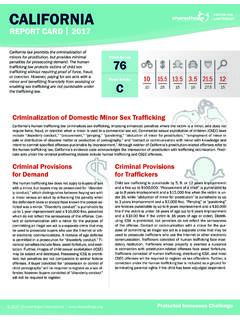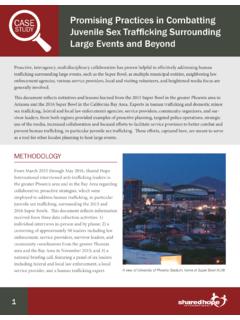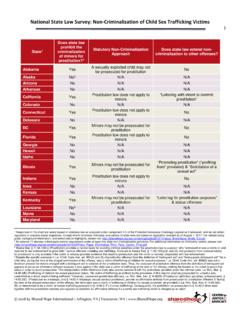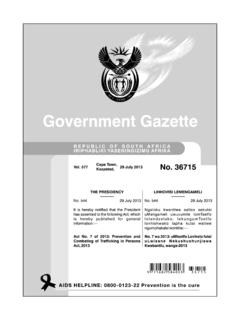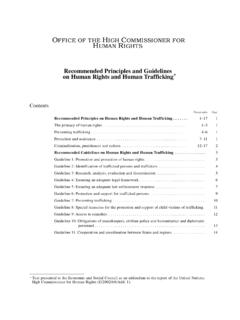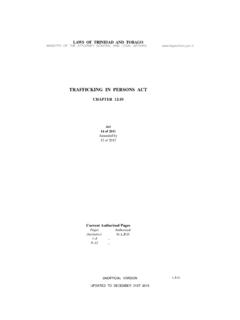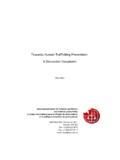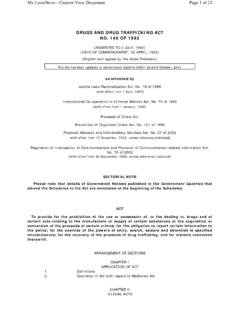Transcription of Justice for Victims of Trafficking Act
1 Justice for Victims of Trafficking Act Section-by-Section Analysis Major Supporting Organizations More than 200 Victims ' rights and law enforcement organizations, including: Shared Hope International, Rights 4 Girls, Fraternal Order of Police, National Center for Missing and Exploited Children, National Association for the Advancement of Colored People (NAACP), National Children's Alliance, National Criminal Justice Association, End Child Prostitution and Trafficking , PROTECT, Alliance to End Slavery and Trafficking , National Association of Police Organizations, National Conference of State Legislatures, National District Attorneys Association. Section1. Short Title; Table of Contents. The Justice for Victims of Trafficking Act of 2015.. TITLE I Justice FOR Victims OF Trafficking . Section 101. Domestic Trafficking Victims ' Fund. Under current federal law (18 3013), all persons convicted of a felony in federal court are required to pay a special assessment of $100 in addition to any additional fines ordered by the judge.
2 Funds collected as a result of this special assessment are used to provide services to Victims and to ensure that criminals are helping to offset the costs of their offenses. Unfortunately, this $100 special assessment is the only monetary penalty that many human traffickers and predators will pay to help offset the costs and harms they have caused. For instance, according to the latest available data from the United States Sentencing Commission (FY 2012), only 12% of federal child pornography/prostitution offenders and 6% of sexual abuse offenders are ordered to pay any criminal fines at all in federal court. To hold predators accountable, the Justice for Victims of Trafficking Act would require certain federal offenders to pay an additional special assessment of $5,000 upon conviction for one of the following classes of crimes: o Human Trafficking ;. o Sexual abuse;. o Child pornography ;. o Child sexual exploitation;. o Interstate transportation for illegal sexual activity; and o Commercial human smuggling.
3 Based upon FY 2012 data from the United States Sentencing Commission (the latest available), this additional special assessment would apply to more than 1. 6,200 offenders per year accounting for at least $31 million in obligated assessments, which would not be payable until all outstanding orders of restitution and other criminal fines are paid in full by the offender. All penalties collected under the Justice for Victims of Trafficking Act would be collected in the same manner that criminal fines are collected under current law, and would be deposited into a deficit-neutral Domestic Trafficking Victims '. Fund. The Attorney General would be authorized to use the balances of this fund to supplement programs that provide Victims ' services to domestic human Trafficking Victims , and provide law enforcement with resources to investigate and combat modern-day slavery. At the end of each fiscal year, all unobligated balances contained in the Domestic Trafficking Victims ' Fund would be automatically transferred to the Crime Victims ' Fund.
4 Section 102. Clarifying the Benefits and Protections Offered to Domestic Victims of Human Trafficking . Under current law, citizen human Trafficking Victims are placed at a disadvantage when seeking restorative services and protection. Under the Trafficking Victims Protection Act, non-citizen Trafficking Victims may become eligible for federally funded services and benefits after HHS or the Secretary of Homeland Security issues an official certification to them but citizens and Lawful Permanent Residents are not eligible for this certification. This disparity in certification has led to confusion, and often has the effect of categorically excluding domestic human Trafficking victim from receiving protective and restorative services. This section clarifies that citizen and Lawful Permanent Resident human Trafficking Victims should never be denied services due to the fact they have not received a victim certification. Section 103. Victim-centered Child Human Trafficking Deterrence Block Grant Program.
5 This section reauthorizes and reformulates an expired section of the Trafficking Victims Protection Act (42 14044b) which relates to services for domestic child Trafficking Victims . More specifically, this section would create a victim-centered model block grant program to help States and local governments develop and implement comprehensive victim-centered programs to train law enforcement, rescue exploited children, prosecute human traffickers, and restore the lives of Victims . This program will be paid for entirely through the Domestic Trafficking Victims '. Fund created by the bill. These block grant funds could be used for specialized training programs, the establishment of anti- Trafficking task forces, Victims ' services and the establishment or enhancement of problem solving court programs for Trafficking 2. Victims all focused on victim rescue and restoration. Collaboration between law enforcement, social services, emergency responders, Children's Advocacy Centers, victim service providers, and non-profits is encouraged in order to help communities and governments work together to develop a holistic approach to fighting Trafficking and serving Victims .
6 Many of the purpose areas in this block grant program (regarding law enforcement and prosecution assistance) passed the Senate by unanimous consent in 2010, and achieved broad bipartisan support in the House, as part of the Domestic Minor Sex Trafficking Deterrence and Victims Support Act.. Section 104. Direct Services for Victims of Child Pornography. Creates a new purpose area under the Victims of Child Abuse Act to allow the more than 900 Children's Advocacy Centers across the nation to provide restorative services for Victims of child pornography. Requires that not less than $2 million per year from the Domestic Trafficking Victims Fund to be dedicated to this purpose. This section also clarifies that Children's Advocacy Centers may use existing resources to work with child Victims of human Trafficking . Section 105. Increasing Compensation and Restitution for Trafficking Victims . Requires law enforcement officials to prioritize the use of proceeds from forfeited assets to satisfy restitution orders in human Trafficking cases.
7 Current federal law requires convicted human traffickers to forfeit all property used or intended to be used to commit or facilitate the commission of such violation. This standard can sometimes be used to shield human traffickers from broad asset forfeiture by requiring prosecutors to make a difficult distinction between the portion of criminal assets traceable to the underlying offense and the portion of the assets that are involved in the offense, but were not used for the actual facilitation of the offense itself. The Justice for Victims of Trafficking Act would amend the human Trafficking asset forfeiture statute (18 1594) to track the asset forfeiture statute for money laundering (18 982(a)(1) eliminating the need for prosecutors to show direct traceability between the underlying crime and the targeted proceeds when they can show that the assets were involved in the crime or used to conceal the source of criminal assets. This provision will make more forfeited criminal assets available for victim restitution and would also incentivize the charging of human Trafficking as the principal offense in federal cases.)
8 This section would also allow the Department of Justice and Department of Homeland Security to use money available in federal asset forfeiture funds to make award payments to victim-witnesses who come forward and provide information or assistance related to a human Trafficking case. 3. Section 106. Streamlining Human Trafficking Investigations. Under current law (18 2516), state and local law enforcement may obtain a wiretap warrant in their state courts upon a showing that the investigation may provide evidence of murder, kidnapping, gambling, robbery, bribery, extortion, or dealing in narcotic drugs, marihuana or other dangerous drugs, or other crime dangerous to life, limb, or property, and punishable by imprisonment for more than one year.. Unfortunately, many state courts have ruled that human Trafficking /. prostitution investigations do not provide evidence of one of the listed classes of offenses essentially precluding state human Trafficking task forces from obtaining wiretaps in these critical cases.
9 For an example of a State Supreme Court interpreting federal law and holding that the investigation of a prostitution ring did not meet this criteria, see: State v. Rivers, 660 1360. (Fla. 1995). See also: People v. Shapiro, 50 747 ( 1980); and United States v. Millstone Enterprises, Inc., 684 F. Supp. 867 ( Pa. 1988). Given the recent growth of state and local human Trafficking task forces, and the ability of wiretap evidence to spare victim-witnesses the burden of confronting their exploiters, we must ensure that this powerful investigative tool remains at the disposal of law enforcement officials. The Justice for Victims of Trafficking Act would clarify that the principle prosecuting attorney of a State or its political subdivision may obtain a wiretap warrant in a state court pursuant to a showing of probable cause that the wiretap will provide evidence of a crime of human Trafficking , child sexual exploitation, or child pornography production. The Justice for Victims of Trafficking Act also extends federal wiretap authority to cover all human Trafficking offenses, specifically peonage, involuntary servitude, forced labor, child sexual exploitation, child pornography production, slavery and involuntary servitude.
10 Section 107. Enhancing Human Trafficking Reporting. The first point of contact for many human Trafficking Victims is a Federal, State, or local law enforcement official. However, despite the violent and degrading nature of human Trafficking , it is not currently required to be classified as a Part I Violent Crime (the most serious classification) for purposes of the FBI's Uniform Crime Reporting (UCR) Program. This section will encourage law enforcement agencies to investigate and report human Trafficking activity by classifying this crime as a Part I Violent Crime and requiring it to be included in the calculation of index crime rates. Section 108. Reducing Demand for Sex Trafficking . 4. The Trafficking Victims Protection Act (TVPA) defines a sex trafficker as a person who knowingly recruits, entices, harbors, transports, provides, obtains, or maintains by any means a person knowing, or in reckless disregard of the fact, that means of force, threats of force, fraud, coercion.
